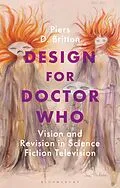The long-running popular TV series Doctor Who is, Piers Britton argues, a 'uniquely design intensive text': its time-and-space-travel premise requires that designers be tirelessly imaginative in devising new worlds and entities and recreating past civilizations. While Doctor Who's attempts at worldbuilding are notorious for being hit-and-miss - old jokes about wobbly walls and sink plungers die hard - the distinctiveness of the series' design imagery is beyond question. And over the course of six decades Doctor Who has produced designs which are not only iconic but, in being repeatedly revisited and updated, have proven to be an ever-more important element in the series' identity and mythos. In the first in-depth study of Doctor Who's costumes, sets and graphics, Piers Britton offers an historical overview of both the original and the revived series, explores theoretical frameworks for evaluating Doctor Who design, and provides detailed analysis of key images. Case studies include the visual morphology of Doctor Who's historical adventures, the evaluative character of cosplay, and the ongoing significance for the Doctor Who brand of such high-profile designs as the Daleks and the TARDIS interior, the 'time-tunnel' title sequence, and the costumes of the Fourth and Thirteenth Doctors.
Autorentext
Piers Britton is Professor and Director of Visual & Media Studies at the University of Redlands, Southern California. He is the author of TARD/Sbound (I.B.Tauris, 2011) and co-author of Reading Between Designs: Visual imagery and the generation of meaning in The Avengers, The Prisoner and Doctor Who (U.T. Press, 2003). He writes mostly on costume and production design for television and film, and is currently developing a book-length study of design for television and film, provisionally entitled Immaterial Culture: Theorizing Design for Screen Entertainment. He teaches on screen genres, television aesthetics, the arts and art theory in the Renaissance, and gender in art and the media.
Klappentext
The long-running popular TV series Doctor Who is, Piers Britton argues, a 'uniquely design intensive text': its time-and-space-travel premise requires that designers be tirelessly imaginative in devising new worlds and entities and recreating past civilizations. While Doctor Who's attempts at worldbuilding are notorious for being hit-and-miss - old jokes about wobbly walls and sink plungers die hard - the distinctiveness of the series' design imagery is beyond question. And over the course of six decades Doctor Who has produced designs which are not only iconic but, in being repeatedly revisited and updated, have proven to be an ever-more important element in the series' identity and mythos.
In the first in-depth study of Doctor Who's costumes, sets and graphics, Piers Britton offers an historical overview of both the original and the revived series, explores theoretical frameworks for evaluating Doctor Who design, and provides detailed analysis of key images. Case studies include the visual morphology of Doctor Who's historical adventures, the evaluative character of cosplay, and the ongoing significance for the Doctor Who brand of such high-profile designs as the Daleks and the TARDIS interior, the 'time-tunnel' title sequence, and the costumes of the Fourth and Thirteenth Doctors.
Inhalt
Table of Contents
Preface
PART 1: A CRITICAL DESIGN HISTORY OF DOCTOR WHO
Introduction: Why a history of Doctor Who design?
1. The London Period - Lime Grove 1963 to Television Centre 1989
2. The TVM, and the Cardiff Period - Upper Boat Studios 2004 to Roath Lock 2020
Postlude
PART 2: THIRTEEN KEY DESIGNS - A PERSONAL VIEW
Introduction
3. Formative and Enduring Images
4. Design of the Times
PART 3: WHAT'S AT STAKE IN DESIGN FOR DOCTOR WHO
Introduction
5. The Work of Design in the Doctor Who Narrative
6. Responding to Design for Doctor Who - Evaluation and Transformations
LAST THOUGHTS
Notes
